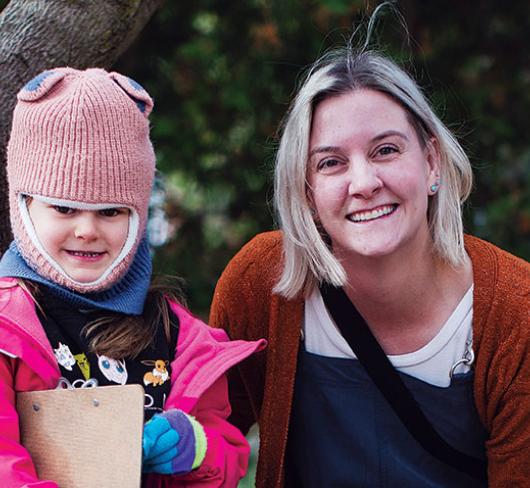
An Eclectic Approach To ESL In Kindergarten
We teach a unique class of intensive ESL junior and senior kindergarten students. We have a minimum of 10 different first languages in our morning and afternoon classes - a total of 80 students from a variety of backgrounds. Some of our students were born in Canada; some are recent immigrants; and some are refugees. The students remain in our classroom for both junior and senior kindergarten.
In past years, we have had a number of English-speaking students in the classroom as well. However, we found they were not interacting with the ESL children very much and therefore not offering themselves as language role models. By having a totally ESL class, we are able to target the students’ language needs with more repetition and consistency.
Resources for the teacher of an ESL kindergarten student are virtually non-existent. For those of us confronted with non-English-speaking four- and five-year-olds, implementing and adapting strategies employed for older students simply doesn’t work. Unlike their older counterparts, ESL earlychildhood students do not have the benefit of being literate in their own languages.
Our research base
Extensive research convinced us that children must understand a concept before they can acquire the language that accompanies that concept (Piaget, 1976). Cummins (1980) also found that it takes longer for cognitive language to develop than oral communication.
Another study concluded that teaching had to be meaningful for children to relate to what is being taught. Listening, speaking, reading and writing must be integrated with concrete objects (Trute, 1990).
Learning occurs best in a low-pressure, enjoyable environment (Goldenberg, 1990). Other studies concluded that children need “ a fun, relaxed atmosphere” to facilitate second language learning (Wagstaff, 1992). Vygotsky (1986) focused on the importance of social interaction and language learning. The study concluded that the greatest gains in kindergarten oral language skills were made with more play time and social interaction (Thomas, Rinehart and Wampler, 1992).
The new Ministry of Education document (1998) outlining expectations for the kindergarten years offers few strategies for the ESL learner. Obvious techniques such as using “ simple, concrete language, conveyed by using pictures, gesture and vocal intonations and volume” are all it suggests. Our experience with ESL kindergarten led us to develop our own resources, strategies and modifications to curriculum.
Profiles of the early childhood ESL student
Two types of ESL learners enter at the kindergarten level. One group of learners takes risks, follows along with the other students and not only observes but also participates in classroom activities and communicates orally. The other group chooses to observe only and is threatened by any teacher intervention or anything perceived to be forced inclusion in activities.
Our program allows this second group of students to integrate at their own pace. Obviously, the second group is more challenging for the teacher. Elowever, we have found that children’s innate curiosity and their need to be with other children will eventually draw them into the group. Sometimes this takes months. Forcing children to speak and participate before they are ready only minimizes trust between teacher and student. The last thing the child wants is to have attention focused on him or her.
Our classroom provides children with a very non-threatening environment. Learning is subversive. English vocabulary is acquired through games and songs instead of intensive drill. Stickers are used as a motivator for participation. It is unnecessary to direct the children’s activities at all times. We allow large blocks of time for children to create and play together. These blocks of time also allow the teacher to move around within the groups to observe individual progress.
Routines and discipline
Fair and consistent adherence to routines and discipline is important for all young children, and especially for the ESL students. The security of predictability is essential for developing selfconfidence. Routines must be established and maintained from September to June. Simplicity is crucial. For example, we do not put names on the coat hooks because most of the children are unfamiliar with our alphabet; we are unsure of the pronunciations of the names; and often the children are too shy to speak to us. Names are taught, later in the term, by using name cards coupled with picture cues for library identification and as a means of dismissing the children from the circle.
Entrance
Initially, something as simplistic as forming a line, with children speaking a minimum of 10 different languages, is a challenge. To establish entry procedures, concrete visual aids are necessary. A picture of a clock with the entry and dismissal times is displayed for the parents, as well as a verbal reminder of the dismissal time. The children are encouraged to wave good-bye to their parents. This also cues the parents that they are not to follow their child into the classroom and eliminates some of the separation anxiety felt by students and parents.
It is essential for students to know exactly what is expected of them upon entry. Coats are removed and hung up. Library books are placed in a designated bin and students sit on the carpet in the circle area and await further instruction.
Stopping classroom activity
It is imperative to have a signal — bell, whistle, lights, etc. — to cease all activity. This provides an opportunity for all students to stop, put their hands on their heads and listen. By placing their hands on their heads they are unable to continue playing and must give the teacher their full attention. This device also is used to provide a “ stop” in activity for safety or disciplinary reasons.
Snack
Through the teachers’ manipulation of snack time, on selected days, new social groups can be formed through random placement of students at tables. Alternately, the children can form their own groups on the days they seat themselves. By using name cards, the teacher is able to prearrange groups and the students are encouraged to identify their own names. This provides an opportunity for the children to interact with all of the students at some time or another. As well as being a social time, snack provides students with the opportunity to learn about manners and acceptable table behaviour.
Toys and games
Toys are organized into bins with a photo and word cue allowing the students to clean up independently.
Games such as Colour and Shape Bingo, Animal Lotto, Around the House Lotto and Number Bingo are played co-operatively with an adult - teacher, co-op student or volunteer - to model correct basic vocabulary.
Although toys and games are commonplace to us, many of the children come with limited experience as to how games are played and how toys are played with appropriately. Early in the year, repeated direction and modelling demonstrate appropriate play and care of toys and manipulatives.
Modifying the curriculum
Regardless of the subject, all curriculum must be modified for the ESL learner. Instructions for any activity require visual representation and repetition for emphasis and language acquisition. Instructions need to be repeated many times during the activities, with an example of the teacher’s expectations. It is a great advantage to have a volunteer or co-op student in the classroom. This allows for another explanation of the activity, with additional assistance to the students. In many cases, the ESL students watch others to ensure that what they are doing is correct. A good model is necessary and, with guidance, some of the students are able to interpret or show others what is expected. Due to language constraints, extra time should be scheduled for students to complete tasks without pressure.
Children are immersed in theme-related vocabulary. Themes continue for a minimum of three weeks to familiarize students with themeassociated oral language. Bulletin boards are created using visuals and written words related to the theme. Pictures are placed on each activity table and are used for sending and dismissing children during activity and snack times. Movies, films, simple stories, posters, etc. are employed to reinforce themes.
One of the greatest motivators we have found is to bring animals and “ experiences” right into the school. We have a classroom pet, Holly, the rabbit. We also have had guest visitors - a litter of seven-week-old puppies, adult dogs, cats and even a pony. We have taken the students to Uncle Porky’s Pig Farm and to the Royal Winter Fair. We have found that the children generate more vocabulary and interest around animal-related themes than any other.
Assessment and evaluation
It is important to continually observe, assess and evaluate the student’s abilities in all aspects of the program. The teacher must be aware of the student’s learning style, skills and abilities. By creating and using a number of vocabulary checklists, we are able to assess the student’s current English vocabulary in common classroom situations or based on current themes. This kind of assessment allows for many different student groupings and enhances opportunities for learning.
Assessment also occurs non-verbally. Students who are still in the silent stage of language may possess many skills. By doing non-verbal “show me” assessments we are able to evaluate the student’s progress. An example of this kind of assessment is, Show me which pencil is longer? Which pencil is the shortest? Which pencil is red? Which pencil is blue? etc. These kinds of questions allow the teacher to evaluate receptive language, without pressuring the student to speak.
Social skills evaluation is on-going. Cultural differences can make this a challenging aspect of any program. By modelling the expectations of behaviour in the classroom and by using pictures, puppets and small skits to explain acceptable social behaviour, the teacher is able to track the students’ receptiveness by their actions. Cause and effect become the benchmarks for this kind of evaluation. This is often where speaking with the students and the help of translators becomes imperative.
Communicating with parents
Communication between home and school is essential. However, ESL parents add a considerable challenge for the kindergarten teacher. Often, the whole Canadian pre-school program has an entirely different philosophy than that understood by the parents. East Indian and Asian early-childhood programs rely heavily on rote learning and an extremely structured day. An explanation of a play-based program and the assurance to parents that their children are indeed learning and developing reading readiness skills is imperative. This can be done by inviting parents, through translators, to observe their child in the classroom. By pre-arranging student translators from senior grades and “ briefing” them on our program, parents can understand the “why” of their child’s day.
Pictorial and translated classroom newsletters keep parents informed on an on-going basis. Often, ESL parents feel isolated by the language barrier. This, coupled with a totally foreign school system, can make parents reluctant to become involved. An inviting approach and translators relieve the stress considerably.
Cindy Hunt and Karen Koop teach ESL Kindergarten at Lake Avenue School, Stoney Creek. Lake Avenue is a K-8 school o f 850 students, 65% o f whom come from homes where English is the second language.
Research References
Cummins, J. “Empowering Minority Students: A Framework for Intervention,” Howard Educational Review, Vol. 56, #1, 1986
Goldenberg, C. “Research Directions: Beginning Literacy Instruction for Spanish Speaking Children,” Language Arts, Vol. 67, Oct. 1990.
Piaget, J. “Early Childhood Education Today,” 4th Edition
George S. Morrison, 1988, Merrill Publishing Company
Thomas, K., Rinehart, S.D., Wampler, S.K. “Oral Language, Literacy and Schooling: Kindergarten Years.” Reading Horizons, Vol. 33, #2, 1992.
Trawick-Smith, J. Interaction in the Classroom: Facilitating Play in the Early Years, 1994.
Trute, J. Improving Basic Language Skills of Limited English Proficient Kindergarten Children, 1990.
Wagstaff, S. Teaching ESL to the Young LEP Child in an Inner City School, 1992, ED3444888.
Professional References
Benedetti, Teresa. “Enhancing Teaching and Teacher Education with Peer Coaching,” TESOL Journal, Vol. 7. N. 1. Autumn 1997.
Eisele, Beverly. Managing the Whole Language Classroom. Creative Teaching Press, 1991.
Kusak, Loretta. Strengthening Your Kindergarten Program. Bureau of Education & Research, 1992.
Law, B. & Eckes, M. The More Than Just Surviving Handbook. Peguis Publishers, 1990.
May, Frank. Reading As Communication. An Interactive Approach. Merrill Publishing Company, 1986.

